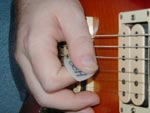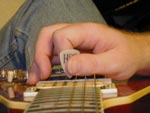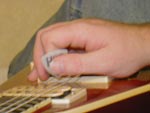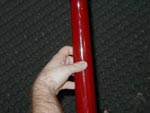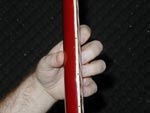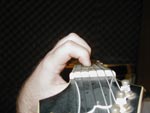Technique
2. Picking technique
3. How long does it take
4. Left Hand stretch
5. étude
6. Vibrato control
7. Scale fingerings for the left hand
8. Right arms/hand pain
9. Major Scales Positions
10. Arpeggios
Question: I've been practicing DIRECTIONAL PICKING for a few hours but I am finding it hard to get used to. After spending so many years alternate picking, my hand wants to revert to the alternate picking all the time, its frustrating. Any tips ?
Answer: Your situation is very common, I went through the same thing when I made the switch from alternate picking to directional picking years ago. The most important thing is patience. You must have patience with Yourself while learning this. Start out really slow. Watch Your picking hand and the pick itself very closely at first. Spend about 1/3 of your practice time on this for now, the other 2/3 of the time, You can just practice as You normally would (with alternate picking). Over time (weeks or months) the directional picking will become more natural to You and then You will be ready to completely make the switch and implement directional picking in Your playing 100% of the time. It's worth the effort, time and frustration.
Question: How do you keep from hitting pinch harmonics when playing scales or sweep picking?
Answer: My palm usually doesn't rest anywhere, since most of the weight of my hand is on my thumb, but the palm can ride along on the bridge. I just do NOT use my palm as an anchor.
Make sure Your thumb is holding the center of the pick and is not hanging over the side of the pick (most players have the tip of the thumb hanging over the side edge of the pick and that causes the harmonics to happen). I use Clayton RT126 picks. In general I prefer heavy picks that are large. In Your next lesson, I'll send You one of my picks and You can check it out.
Question: Right now I am trying a small (probably half size or a little smaller) pick which is 1.50 mm thick, and I was just wondering if you had any recommendations?
Answer: Your thickness is good but the small size is forcing Your thumb to hang over the side edge probably.
Breakthrough Guitar Lessons Page
Top of This Page
Question: Should I try to use directional/economy picking when doing the exercises?
Answer: Yes.
Question: Rhythm playing exercise 2. Now that I am playing this at a faster tempo (160bpm) I am starting to inadvertently strike the open D string with the pick. Any specific technique to avoid this?
Answer: You must keep the amount of motion the pick makes small. If You are hitting other strings, then the pick is moving too far away from the string You are trying to play.
Question: Do you think it's important to keep all of the fret hand fingers close to the fretboard at all times?
Answer: Whenever possible, yes.
Breakthrough Guitar Lessons Page
Top of This Page
Question: How long does it take you to have a new technique (i.e. lick, run, arpeggio etc.) to be usable in your playing?
Answer: It depends on the technique. Some techniques have taken me years and others have taken only a few minutes. I'm working on a technique now that I've been practicing for several months and it may take me another 2-3 years to master it to the point where I would use it, but it will be worth it once I am its master and it no longer masters me!
Top of This Page
Question: Right now, in the first 6 or 8 frets on the neck, about all I can manage for a spread is 4 frets, for example index finger at fret 3 and pinkie at fret 7. Are there any exercises other than the practice work that will help increase my reach?
Answer: The answer lies in the thumb of Your left hand, not in the other 4 fingers. Look at the photos of my left hand position:
Top of This Page
Question: I don't understand bars 5-8 of the chromatic scale étude. Is the objective of it to practice position changes? It got me quite confused. The first 4 bars look fairly like a normal scale pattern the next ones doesn't. Why?
Answer: Chromatic scale étude, this is an étude that uses the chromatic scale. There are some string skipping sections (measures 5-8) that focus on using the string skipping technique with position shifts using the chromatic scale, this is a very valuable technique to practice for both Your left and right hands.
Top of This Page
Question: Your comments on Vibrato control were fine, but just what should I be doing in the way of practicing it, other than trying to remember your instructions?
Answer: You do not have to put this off until later. Whenever You play or improvise, try applying vibrato to notes that are sustained (held out). Listen for vibrato when listening to music, in particular pay attention to guitarists and good singers to get a good feel for this. Vibrato is something You should work on every time You play a melody, solo, etc.
Question: Any suggestions for improving bent string vibrato?
Answer: Work with a tuner and a metronome. Bend a B note up to C, and as You apply vibrato, use the tuner to make sure the vibrato is consistently being bent and released to the same pitch on the tuner (it does not matter right now how far You do the vibrato, just get it consistent in pitch and use the metronome so that You are bending and releasing in the same interval of time (maybe one bend and release per beat, metronome at 60, 80, 100, 120 and then 150 beats per minute Also check out my article Vibrato Control.
Top of This Page
7. Scale fingerings for the left hand
Question: When practicing modes, what fingerings should I use on those long stretches, such as 3-5-7 frets or 8-10-12th frets. I have another book with modes and they don't spread things out that much on each string. Is this a better way?
Answer: All examples will be based from the 5th fret (to make this example simple and easy to see).
Frets: 5-6-8 Fingers: 1 2 4 Frets: 5-7-8 Fingers: 1 3 4 Frets: 5-7-9 Fingers: 1 2 4 Frets: 5-6-9 Fingers: 1 2 4 Frets: 5-8-9 Fingers: 1 3 4
It doesn't matter how high or low you are on the fretboard, I recommend to maintain the fingerings for the shapes above. It is true that many guitar scale books do not teach the scales with the 3 note per string system that I do, but that is mainly because those books are outdated and have not caught up with advancements in electric guitar virtuosity. Most of the great virtuosos (like George Bellas, Jason Becker, Yngwie Malmsteen, Paul Gilbert, Tony McAlpine, Michael Angelo, etc.) use the 3 note per string fingerings because they know that this is the best way to play scales.
Question: When reading the tab / music, what do these symbols mean: "n" and "v" ?
Answer: These symbols refer to picking direction. The first symbol means to pick the note down (towards the floor), the second symbol is the opposite, it means to pick up (towards you).
Top of This Page
Question: After a short time, my thumb on the picking hand starts to hurt a little. I hold my pick with the tip of my thumb bent a little backwards and I hold it quite firmly/hard. I hold the pick at an angle of 45° against the strings. That means I don't hold the pick horizontally to the strings. Also, after doing this 8th note pattern, my arm starts to hurt a little too, although in a different way. In the thumb, it is the strain on the joint that hurts, and in my arm it is the muscles that hurt with strain. What can I do about these things? I tried to hold the pick differently, but I would like to hear your thoughts first, because I don't want to go from one bad pick holding technique to another.
Answer: The only reason that You are feeling pain is due to tension in Your hand, arm and probably Your shoulder too. Your thumb does not need to be bent at all. I'm sending You photos of my hand holding the pick so that You can see exactly what I'm talking about. Notice that my thumb is straight. Because it is straight, it is also relaxed. You may need to slightly adjust Your hand position to get the pick angle You want. I do think that a 45 degree angle is too much. A 10-30 degree angle should be better, try it. The main thing You can do to relieve tension and pain is to stop holding the pick so tightly. Sure, You do need to hold it firmly enough so that it won't come out of Your hand, but Your adrenaline is taking over and is causing You to hold on too tightly. You can still play aggressively with a relaxed hold on the pick. Concentrate on relaxing Your arm, shoulder and fingers.
Top of This Page
Question: Picking pattern ascending: in the passage from a string to the next one, do I have to do down picking 2 times in a row? (i.e.: E string: Down-Up-Down then A string: again Down-Up-Down and so on)? And do I have to do up picking 2 times consequently in the descending scale? I'm asking you this because of the "ghost of alternate picking", I always heard "that I always need to use alternate picking". So I don't want to do it if not necessary...
Answer: Yes pick in the way You described (and as described in the lesson). Forget about alternate picking for these scales. Directional picking is superior.
Question: If not specified, when you say Major scale do you always mean the Ionian?
Answer: When I refer to the fingering and I say major scale, I am talking about the Ionian fingering yes.
Question: In the scale positions fingering, the first note on the low E string (using the first finger) in all the scale positions is always the first (root) note of the scale? So if I want to play an A Major scale, do I start with my first finger on the low E string from the 5th fret?
Answer: Yes.
Top of This Page
Question: When picking in a sweep arpeggio, I noticed that in order to avoid twisting my wrist uncomfortably, I have to shift the hand, i.e. the G string is picked between the 2 pickups, the B string nearer to the neck pick up. and the high E nearly over the neck pick up. Is this correct, or should I sweep perfectly perpendicular to the strings?
Answer: I recommend keeping Your hand more perpendicular to the strings. Check out my videos and You will see that motion.
Question: I have a problem on the sweep arpeggio étude: when doing an A minor, 5th fret, all the notes are played with a mini-barre. When going "up", the base of the right thumb stops the strings, and going "down" I should "roll" the finger, but often this is not enough to stop the strings from ringing. Do you have any idea on how to correct my "rolling" movement?
Answer: Make sure the tip of Your left hand index finger just barely touches the 3rd string, this way it will be easier to roll off the 1st and second strings...
Breakthrough Guitar Lessons Page
Top of This Page

